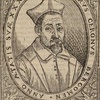
Pietro Cerone Sheet Music
- Born: 1566
- Died: 1625
- Birthplace: Bergamo, Italy
Pietro Cerone was an Italian music theorist, singer and priest of the late Renaissance. He is most famous for an enormous music treatise he wrote in 1613, which is useful in the studying compositional practices of the 16th century. Cerone was musically conservative, and his conservatism in this influential treatise doubtless had some effect on the delay of the Baroque style arriving in Iberian peninsula. In his writing he was generally contemptuous of Spanish composers, and lavish in his praise of Italians (which may partially account for the abuse heaped on him by Spanish critics). He discusses the previous theoretical treatises of Zarlino, Vicentino, Juan Bermudo and others; he describes in detail how a composer can achieve expressive intensity when writing masses, motets, madrigals, frottolas, canzonettas, canticles, hymns, psalms, lamentations, ricercares, tientos, strambotti, and other forms of the time. The compositional ideal which he maintained was the style of Palestrina, though curiously he maintained that the "rules" of counterpoint were made to be broken, and should be abandoned as soon as a composer had learned his craft: paradoxically, even in the 21st century, no style of composition is taught in a more rigorous, rule-based way than the polyphonic idiom of Palestrina.